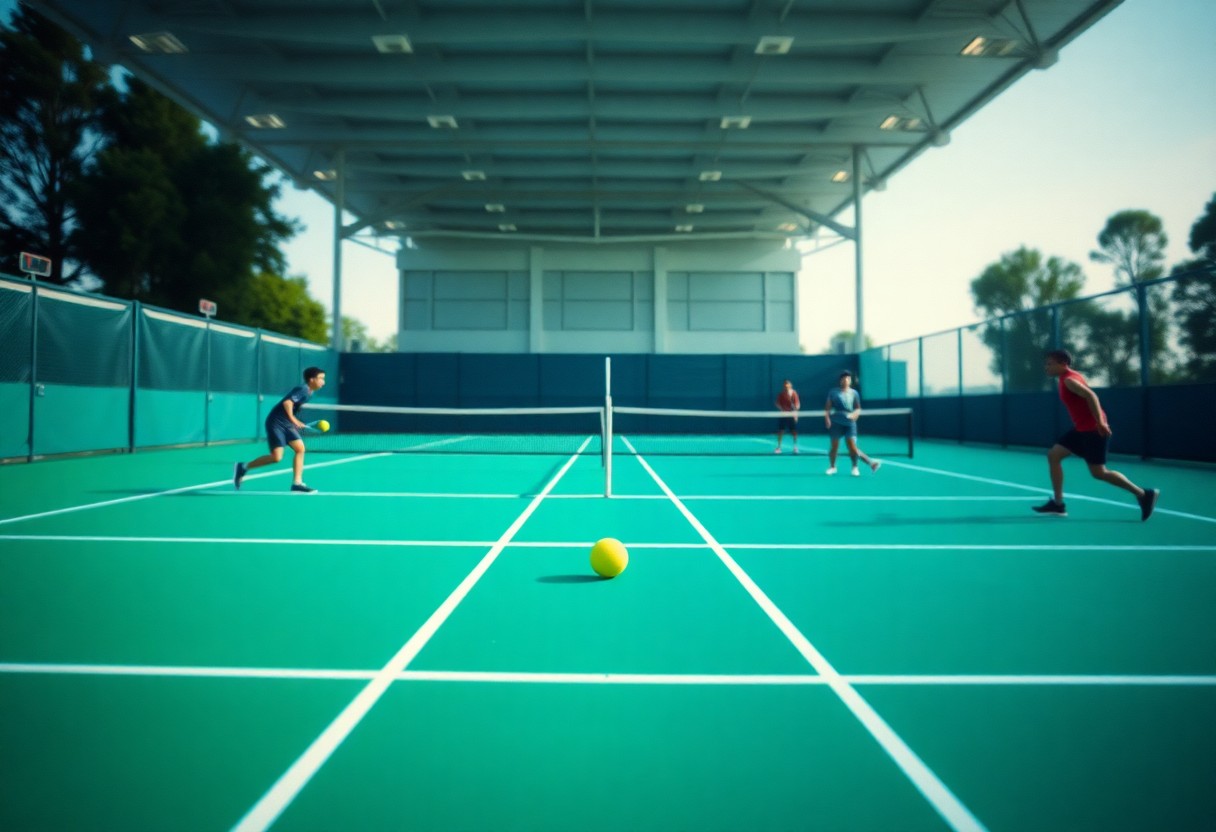This guide offers strategic insights into how to shift from a defensive to an offensive mindset on the tennis court. By mastering momentum control, players can not only enhance their performance but also dictate the flow of the match. Utilizing effective tactics such as positioning, shot selection, and mental fortitude can transform a passive game into one that overwhelms opponents. Implement these tips to gain the upper hand and dominate your matches.
Understanding Types of Momentum in Tennis
In tennis, momentum is not just a fleeting feeling; it influences match outcomes significantly. Players experience varying types of momentum: Offensive and Defensive, each leading to specific strategic advantages. Properly recognizing and harnessing these moments can change the tide of a match. Offensive momentum enhances a player’s confidence and aggression, while Defensive momentum focuses on resilience and patience. Knowing how to effectively switch between these types is crucial for maintaining control on the court.
| Type | Characteristics |
| Offensive | Increased aggression, confidence, and shot selection |
| Defensive | Patience, resilience, and countering opponent’s aggression |
| Shift | Momentary transitions between strategies |
| Psychological | Mental impact of winning or losing points |
| Physical | Stamina and energy management affecting play |
Offensive Momentum
Offensive momentum occurs when a player seizes control, showcasing dominance through aggressive shot-making and tactical pressure. With this momentum, players can dictate play, leading to high-energy rallies and opportunities to break their opponent’s rhythm. Examples include consistently attacking the net or executing powerful serves that catch opponents off-guard, boosting a player’s confidence and overall match presence.
Defensive Momentum
Defensive momentum emerges when a player focuses on staying in the rally rather than outright attacking. It involves absorbing pressure and forcing opponents to make mistakes. This phase is vital, particularly during long rallies or when facing a particularly aggressive opponent. Players often resort to consistent, deep shots and strategic positioning to elongate points, which can frustrate the attacker and shift the game dynamics.
During defensive momentum, a player can create openings by rallying effectively and waiting for the right moment to strike back. For instance, by using a combination of deep shots and slice returns, they can disrupt the rhythm of an aggressive opponent. When executed well, defensive play not only mitigates the opponent’s offense but can lead to unexpected offensive opportunities, illustrating the delicate balance between offense and defense in high-stakes matches.
Key Factors Influencing Momentum Control
Momentum in tennis can be shaped by several key factors. The ability to pivot from a defensive stance to an offensive strategy hinges on player mindset, physical condition, and environmental influences. Understanding these elements allows players to harness energy shifts and convert them into tactical advantages. Any successful player must be attuned to these dynamics to sustain momentum throughout a match.
- player mindset
- physical condition
- environmental influences
Player Mindset
A player’s mindset significantly affects momentum control. Confidence and focus enable players to seize opportunities and push offensive plays, whereas negative thoughts can lead to hesitancy and errors. Staying mentally resilient, especially during challenging phases, fosters a sense of dominance in the match.
Physical Condition
Physical condition is vital for maintaining agility and power, directly impacting momentum control. Players must ensure they are fit enough to endure lengthy rallies and recover quickly between points. Endurance training enhances stamina, while strength training bolsters shot explosiveness and defensive capabilities.
Optimal physical condition involves a holistic approach, including proper nutrition, hydration, and recovery strategies. For instance, tennis players typically engage in cardiovascular exercises to build stamina and include strength training to enhance their shot power and quickness. A study found that players with higher VO2 max levels, indicative of better aerobic fitness, win 20% more matches against lower-fitness opponents. This demonstrates how integral a well-rounded fitness regimen is for executing aggressive plays and maintaining control over the match’s tempo.
Step-by-Step Strategies to Shift Momentum
| Recognizing Opportunities | Identify moments when opponents appear vulnerable, such as after an error or during a changeover. Use these instances to strike when they least expect it. |
| Implementing Offensive Tactics | Transition from defense to offense by employing aggressive shots like volleys, drop shots, and powerful groundstrokes. Overwhelming your opponent can establish control. |
Recognizing Opportunities
Identifying opportunities is important for shifting momentum. Watch for signs of weakness in your opponent, such as delayed reactions or lackluster shot execution. This awareness allows players to capitalize on key moments, enabling aggressive plays that disrupt the opponent’s rhythm.
Implementing Offensive Tactics
Shifting the momentum requires decisive action. Focus on employing offensive tactics like forcing your opponent into uncomfortable positions and utilizing angles to create openings. For example, a well-timed drop shot can coax your opponent forward, leaving them vulnerable to a deep shot on the next play. Incorporating a mix of pace and placement puts additional pressure on their defense, effectively transforming the match dynamic in your favor.
Essential Tips for Sustaining Momentum
To maintain momentum during a match, focus on physical conditioning, mental resilience, and strategic shot selection. Consistent practice improves stamina, enabling players to endure long rallies. Additionally, developing a positive mindset helps athletes overcome setbacks, while choosing the right shots keeps the pressure on opponents. Stay aware of the game’s rhythm, adjusting tactics as needed. This will create opportunities to seize momentum.
- Physical conditioning
- Mental resilience
- Strategic shot selection
Effective Communication with Coaches
Engaging in open and effective communication with coaches enhances on-court performance. Regular feedback about strategies and techniques can adjust your game plan during matches, allowing for rapid adjustments. Discussing opportunities for improvement fosters a collaborative environment, enabling players to refine their tactics for sustaining momentum. Clear dialogue also strengthens trust and understanding, vital for peak performance under pressure.
Adapting to Opponent’s Play Style
Observing and analyzing an opponent’s play style is imperative for gaining an advantage. Early in the match, identify their strengths, such as a powerful serve or aggressive volleys. Adapt your strategy accordingly; for instance, if facing a hard hitter, focus on defensive positioning to return the ball effectively. Utilizing variations in shots can disrupt their rhythm, shifting the momentum in your favor. Being flexible and responsive to their approach will provide critical insights to exploit their weaknesses throughout the match.
Pros and Cons of Different Strategies
| Pros | Cons |
|---|---|
| Creates scoring opportunities | Risk of unforced errors |
| Disrupts opponent’s rhythm | Can lead to overcommitment |
| Boosts player confidence | Potential fatigue from aggressive play |
| Utilizes opponent’s weaknesses | Strategic errors can be magnified |
| Controls the pace of the match | Requires high-risk decision-making |
| Enhances crowd engagement | Less room for recovery in rallies |
| Dictates court positioning | Increased pressure to maintain levels |
| Encourages aggressive shot-making | Vulnerability to counter-attacks |
| Promotes adaptability in matches | Can lead to tactical confusion |
| Develops skilled shot variations | Less effective against strong defenses |
Advantages of Offense-focused Play
An offense-focused approach enables players to dictate the match tempo, orchestrating points through aggressive shot placement and strategic positioning. By putting pressure on opponents, offensive players can exploit weaknesses, forcing errors and reducing their opponents’ options. This assertiveness often translates into higher confidence levels and better execution during critical moments, ultimately leading to a stronger overall performance.
Disadvantages of Overcommitting
While aggressive play can be beneficial, overcommitting may lead to significant drawbacks. Players who consistently push for winners are at risk of excessive errors, which can shift momentum back to the opponent. The high pace of play can also lead to mental strain, causing lapses in focus and strategy when it matters most, particularly during longer matches or critical points.
Overcommitting often manifests as a tendency to chase down every opportunity for a decisive shot, which increases the likelihood of unforced errors. This tendency not only disrupts a player’s rhythm but also lowers overall effectiveness, as technical precision becomes compromised. Furthermore, the pressure to maintain an aggressive stance can lead to exhaustion, making recovery between rallies increasingly difficult. Hence, while playing offensively can create opportunities, striking a balance is necessary to maintain composure and control throughout the match.
Common Mistakes to Avoid
Avoiding pitfalls is important to shifting from defense to offense. Many players unknowingly fall into traps that can derail their strategies and impede their performance. Recognizing typical errors and learning to sidestep them will significantly enhance one’s ability to maintain control over the match’s momentum.
Misreading the Game Flow
Failing to accurately gauge the dynamics of a match can lead to poor decision-making. Players often struggle to assess their opponent’s strengths and weaknesses accurately, which may cause premature attacks or excessive caution during critical points. This misalignment can prompt lost opportunities for momentum shifts.
Ignoring Personal Strengths
Players frequently overlook their own skills in favor of mimicking successful strategies seen in professionals. This tendency can diminish effective shot execution and overall performance. Understanding and leveraging unique strengths, whether it’s an exceptional serve or agile net play, is key to establishing authority in the match.
Emphasizing individual strengths like powerful groundstrokes or quick reflexes simplifies shot selection and enhances confidence. Choosing play styles that resonate with personal capabilities ensures players capitalize on natural advantages. For instance, a player with a strong forehand should prioritize aggressive baseline rallies rather than relying solely on defensive strategies, enabling more effective control of the game pace.
Conclusion
Taking this into account, successfully shifting from defense to offense in tennis requires an understanding of both strategic positioning and mental preparedness. By anticipating your opponent’s shots and employing effective tactics such as aggressive footwork and shot selection, players can seize control of the momentum. Developing a proactive mindset and maintaining focus under pressure are important in executing these strategies. Ultimately, the ability to dictate play not only enhances performance but also elevates overall competitiveness within the match.
FAQ
Q: What are some effective strategies to shift from a defensive to an offensive playing style in tennis?
A: To transition from defense to offense, focus on aggressive shot selection, including deep groundstrokes aimed at corners, and incorporate frequent net approaches. Utilize your opponent’s weak shots to capitalize on opportunities. Practicing tactical positioning and anticipating your opponent’s moves can also enhance your offensive play.
Q: How can I improve my mental game to maintain momentum during a match?
A: Developing a strong mental game involves visualizing successful plays, maintaining positive self-talk, and setting small, achievable goals during matches. Incorporating breathing exercises can help manage stress. Staying focused on each point rather than the match score aids in maintaining momentum.
Q: What role does footwork play in controlling momentum in tennis?
A: Footwork is necessary for positioning and balance, allowing players to execute shots effectively. Quick and agile movements enable players to get to the ball earlier, setting up offensive plays. Training for agility and stamina can enhance footwork, directly impacting the ability to control the pace and rhythm of the match.




